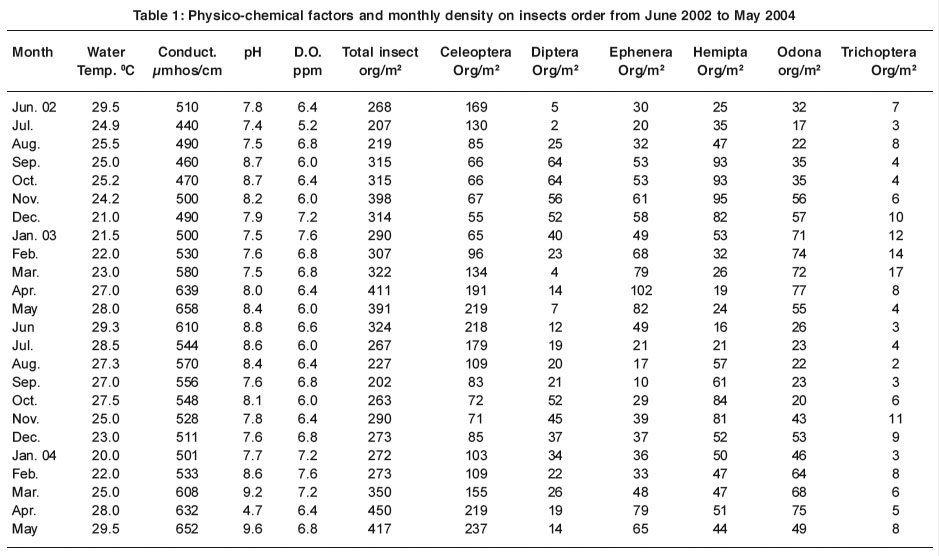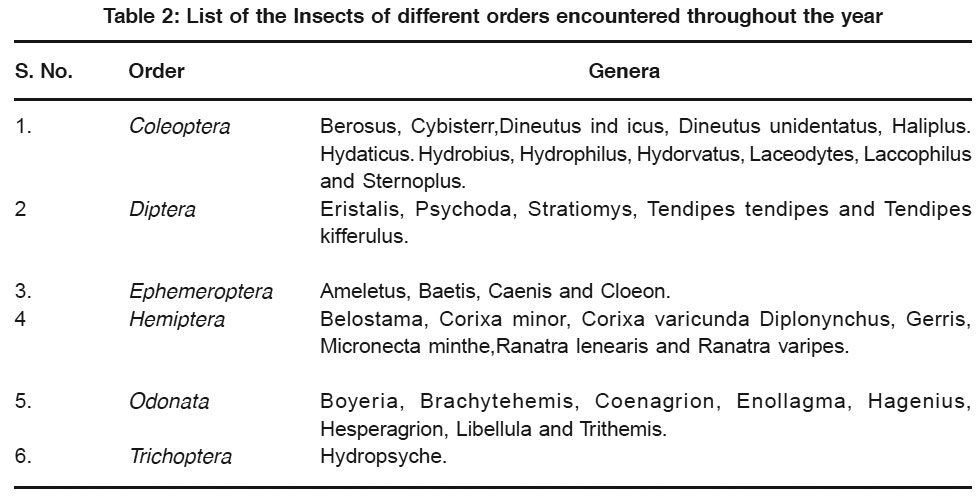Statistical approach to monthly variations of physico-chemical factors at Lower lake of Bhopal in relation to insect fauna
Ishart Mohi-ud-din1 * , Madhulika Singh1 and K. Borana2
1
Department of Applied Aquaculture,
Barkatullah University,
Bhopal,
462 016
India
DOI: http://dx.doi.org/10.12944/CWE.4.1.33
A study on monthly variations of insects was made in Lower lake of Bhopal, during June 2002 to May 2004. Coleoptera, Diptera, Ephemeroptera, Hemiptera, Odonata and Trichoptera dominated insects, The density of total population of insects ranged between 201 org/sqm to 450 org/sqm having higher percentage composition of Coleoptera during most of the study period. Physico-chemical factors (water temperature, conductivity, pH and dissolved oxygen) were also estimated and their correlation with total insect density was established.
Copy the following to cite this article:
Mohi-Ud-Din I, Singh M, Borana K. Statistical approach to monthly variations of physico-chemical factors at Lower lake of Bhopal in relation to insect fauna. Curr World Environ 2009;4(1):196-198 DOI:http://dx.doi.org/10.12944/CWE.4.1.33
Copy the following to cite this URL:
Mohi-Ud-Din I, Singh M, Borana K. Statistical approach to monthly variations of physico-chemical factors at Lower lake of Bhopal in relation to insect fauna. Curr World Environ 2009;4(1):196-198. Available from: http://www.cwejournal.org/?p=939
Download article (pdf)
Citation Manager
Publish History
Select type of program for download
| Endnote EndNote format (Mac & Win) | |
| Reference Manager Ris format (Win only) | |
| Procite Ris format (Win only) | |
| Medlars Format | |
| RefWorks Format RefWorks format (Mac & Win) | |
| BibTex Format BibTex format (Mac & Win) |
Article Publishing History
| Received: | 2009-04-20 |
|---|---|
| Accepted: | 2009-05-30 |
Introduction
Aquatic insects play important role in the aquatic community. They are involved in the mineralization and recycling of organic matter. Bioindicators are organisms employed to assess general toxicity of the environment. These organisms by their presence or absence and in all features of their phenotype and physiology serve as an indicator of environmental status. Thus both the positive and negative facts of the environment can be monitored through biological system. Several biotic and abiotic factors influence the productivity of aquatic insects and an understanding of these factors has become an essential pre-requisite for maintaining not only the aquatic insects but also the animals that depend on them for their food.
The Indian aquatic insects are described by several authors some important contributions are by Tonapi and Rao (1970), Reddy and Pandian (1972), Kapoor (1974), Kumar (1980), Mishra (1985), Oomachan (1988), Saxena et al., (1989), Kumar (1993), Sridharan et al. (2000) and kandibane et al. (2005).
Material and Methods
The study of the physico-chemical parameters and insects were carried out in Lower lake of Bhopal from June 2002 to May 2004. The mud sample were collected with Ekman Dredge sampler at monthly intervals. After that mud was sieved out through 0.5 mm mesh size sieves according to Jonasson (1995) and Hovgaurd (1963) method. Physico-chemical parameters such as conductivity, pH and dissolved oxygen were estimated according to APHA (1995). Correlation between insects and certain physico-chemical parameters were computed.
 |
Table 1: Physico-chemical factors and monthly density on insects order from June 2002 to May 2004 Click here to view table |
Results
The insects were represented by six orders viz., Coleoptera, Diptera, Ephemeroptera, Hemiptera, odonata and Trichoptera (Table 1). Altogether 38 insects species were identified in which 12 belong to Coleoptera, 5 belong to Diptera, 4 belong to Ephemeroptera, 8 eachto Hemiptera and Odonata and 1 belong to Trichoptera (Table 2). The total insect density ranged from 202 org/sqm in September 2003 to 450 org/sqm in April 2004 of all the studied insect population in this lake,Coleoptera was the most dominant and abundant order and it ranged between 55 org/sqm in December 2002 to 237 org/sqm in May 2004. Dipterans ranged from 2 org/sqm in July 2002 to 64 org/sqm in October 2002, Ephemeropterans ranged from 10 org/sqm in September 2003 to 102 org/sqm in April 2003, Hemipterans ranged from 16 org/sqm in June 2003 to 95 org/sqm in November 2002, Odonatans ranged from 17 org/sqm in July 2002 to 77 org/sqm in April 2003. The last dominant group of insect was Trichoptera and it ranged between 2 org/sqm in August 2003 to 17 org/sqm in March 2003.
 |
Table 2: List of the Insects of different orders encountered throughout the year Click here to view table |
The correlation coefficient values of total insects with certain physico-chemical parameters were established. Total insects showed direct and significant correlation with conductivity (r = 0.68, p«1), pH (r = 0.64 P«1) and dissolved oxygen (r=0.72, P«1).
Discussion
The present study showed that the highest insect population was observed in summer months (April and May) in Lower Lake. Michael (1968) recorded the presence of Chironomus larvae from October to May. Greenfield and Ireland (1978) and Stoneburner and Smock (1979) recorded the highest number of insects in May. Nebeker (1971) reported that increased temperature the emergence of aquatic insects.
The majority of insect species found in average eutrophic water body can tolerate a broad range of physico-chemical conditions of water, which render them useless and some of them adopt and become indicators of the water quality (Roback, 1962). David and Ray (1966) observed that May flies and Damsel fly Nymphs and Hemipteran bugs were found inhabiting in the comparatively well-oxygenated zone. Crosswill (1949) observed that Ephemeropteran nymphs and larvae, Odonates, Dipterans beetles and water bugs require low oxygen while some other caddish fly and May fly larvae require higher oxygen contents. According to Roback (1962) the Odonata are not sensitive group, they can not tolerate high changes in pH.
It has been well established that insect communities depend directly or indirectly on different physical and chemical factors, which interact with each other. In the present study total insect density showed direct and significant correlation with conductivity, pH and dissolved oxygen.
References
- American public Health Association (APHA), “Standard Methods for the examination of water waste water”, 18th Edn. American public Health Association, Washington, D.C (1995).
- Crosswell, H., “Value of the bottom samples in demonstrating the effects of pollution on fish food organisms and fish in Shenandoan river”. The Prog. Fish Cult. (1949) 11: 217-220.
- David, A. and Ray, P., “Study on the pollution of the river Daha (N. Bihar) by sugar and distillery wastes’. Evi. Hlth. (1966) 8: 6-35.
- Greenfield, J.P. and Ireland, M.P., “A survey of the macrofauna of a coal waste polluted Lanka Shireflurial system”. Environ. Polln. (1978) 16: 105-127.
- Hovgaurd, P., A new system of sieves for benthic samples. Sarsia, (1963) 53: 15-18.
- Janasson, P.M., The efficiency of sieving techniques for sampling fresh water bottom fauna. Oikos, (1955) 6: 183-207.
- Kandibane, M., Raguraman, S. and Ganapathy, N., Diversity of aquatic Hemiptera in a rice ecosystem of Madurai, Indian J. Environ. & Eccoplan. (2005) 10(2): 489-492.
- Kappor, N. N., Some studies on the respiration of stone fly Nymphs paragnelina media (walker). Hydrobiologia, (1974) 44: 37-47.
- Kumar, A., Studies on the life history of dragon flies, Ceriagrion caromandelianum (Fabricus) (Oenagriidae Odonata). Rec. Zoll. Surv. Ind. (1980) 76: 248-258.
- Kumar, S., Insect communities of the high altitude lake Dashauha, Himachal Pradesh, India, J. Ecobiol., (1993) 5(4): 251-254.
- Michael, R.G., Studies on the bottom fauna in a tropical fresh water fish pond Hydrobiologia, (1968) 31: 203-230.
- Mishra, N. (1985). The effect of sewage with special reference to aquatic insects in the river Kshipra. Ph.D. Thesis,Vikram Univ., Ujjain (MP).
- Nebekar, A.V., “Effect of high winter water temperature on adult emergence of aquatic insects”. Water Res. Pergamon Press, (1971) 5: 777-783.
- Oomachan, L., Macrobenthos of Lower lake, Bhopal. Proc. Nat. Symp. Past, Present and Future of Bhopal lakes, (1988) 27-31.
- Reddy, R.S. and Pandian, T. J., Heavy mortality of Gambusia affinis reared on diet restricted to mosquito larvae. Mosquito News, (1972) 32(1): 108-110.
- Roback, S.S., “Environmental requirements of Trichoptera. Biological Problems in water Pollution, IIIrd Seminar”. Hlth. Serv. Publ. 999, W.P., (1962) 25: 118-126.
- Saxena, M.N., Sharma, S. and Kaushik, S, Studies on aquatic insect ommunities and their distribution. J. Hydrobiol., (1989) 5(1): 39-420.
- Stoneburner, D.L. and Smock, L.A., “Seasonal flutuations of macroinvertebrate drift in a South Carolina piedmont Streanm”. Hydrobiologia, (1979) 63(1): 49-56.
- Sridharan,S., Balasubramani, V., Jeyarani, S. and Sadakathulla, S., Aquatic hemiperan predators in rice ecosystem. Insect environment. (2000) 5: 189-190.
- Tonapi, G.T. and Rao, H.N.M., A biometrical analysis of growth in larvae of Dineustes indicus. Aube (Cryrinidae coleopteran). Ind. J.Ent., (1970) 32(1): 39-50.






